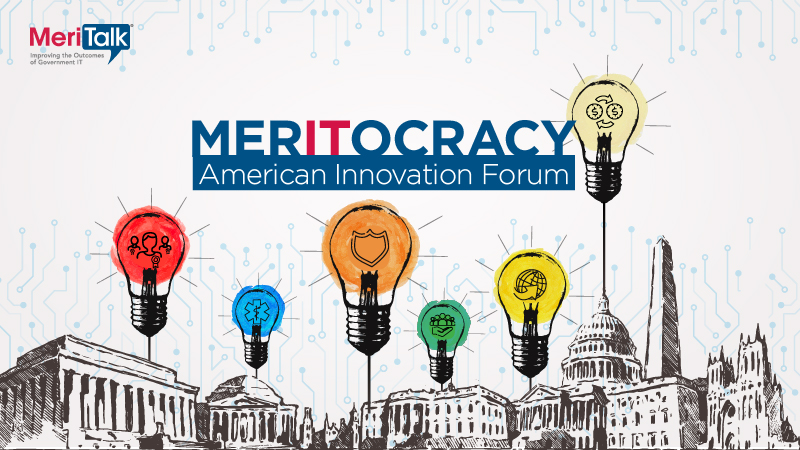
Can mega-scale policy innovation that embodies the highest notes of the American ideal – equality of opportunity in the technology age – sink its roots into the Federal government and help remake the nationwide workforce into a fairer, fuller, and more inclusive engine for the next chapter of American growth and innovation?
On July 21 – we’re going to find out. The countdown to MerITocracy 2022: American Innovation Forum is on.
The in-person forum – at the Marriott Marquis in Washington, D.C., from 8:00 a.m. to 6:00 p.m. – will host bipartisan leaders from Congress, the Biden administration, and America’s tech industry to examine the most pressing problems facing citizens in our democracy, and map out creative solutions from the nexus of policy and technology. We invite you to register for MerITocracy today.
In the lead-up to the July 21 forum, we are table-setting a host of big issues that will get serious attention at MerITocracy 2022. The overarching question we are asking is this: can technology innovation – coupled with the boldest kind of leadership – work together to start fixing the most intractable problems facing America?
In today’s edition of Countdown to MerITocracy, we’re talking about gaps, fixes, and potential payoffs of the Federal government’s mounting full-court press on closing the technology equality and workforce gap. There’s a lot on the policy agenda, but little certainty on the ultimate extent of the payoffs.
Here’s a brief issue tracker on three big current policy efforts and what they aim to achieve.
And keep in mind that with Dr. Janice Underwood, Director of the Office of Diversity, Equity, Inclusion, and Accessibility at the Office of Personnel Management (OPM), we’ll be hearing a lot more about the latest developments. Dr. Underwood will talk about inequalities in the workforce, and how driving a more diverse workforce is critical to the next phase of American innovation.
Step One – DEIA Strategic Plan
Last November, the White House released a government-wide strategic plan to advance diversity, equity, inclusion, and accessibility (DEIA) for the Federal workforce, as required under President Biden’s DEIA executive order (EO) issued in June 2021.
The strategic plan aims to help agencies implement the DEIA EO and provide a roadmap for agencies to follow to strengthen DEIA in their workforce policies, practices, and culture.
“Even with decades of progress building a Federal workforce that draws from the full diversity of the nation, many underserved communities remain under-represented in the Federal workforce, especially in positions of leadership,” the plan says. “As the nation’s largest employer, the Federal workforce must be our country’s model of excellence for diversity, equity, inclusion, and accessibility.”
The plan provides agencies with five operating principles to advance and sustain DEIA. These include:
- “Use data and evidence-based decision-making;
- Focus on continuous improvement;
- Adopt a collaborative whole-of-agency mandate with partnership engagement;
- Prioritize accountability and sustainability; and
- Understand the perspectives of the workforce and the customers.”
Step Two – the PMA
The Biden administration’s President’s Management Agenda (PMA) published last November ties Federal workforce and DEIA issues tightly within broader government policy, and as one of three top issues that headline the PMA. As such, look for those issues to be pursued government wide through at least 2024. The major strategy tenets include:
- Attracting and hiring “the most qualified employees, who reflect the diversity of our country, in the right roles across the Federal Government”;
- Making “every Federal job a good job, where all employees are engaged, supported, heard, and empowered, with opportunities to learn, grow, join a union and have an effective voice in their workplaces through their union, and thrive throughout their careers”;
- Reimagining and building “a roadmap to the future of Federal work informed by lessons from the pandemic and nationwide workforce and workplace trends”; and
- Building “the personnel system and support required to sustain the Federal Government as a model employer able to effectively deliver on a broad range of agency missions.”
Part Three – Skills Emphasis
A third major policy shift that may also help bend the workforce curve in favor of the Federal government kicked off in earnest earlier this year when OPM issued guidance implementing a Trump-era executive order (EO) that instructs agencies to expand skill-based hiring and decrease reliance on educational accomplishments and self-assessments to evaluate prospective employees.
According to the guidance released May 19, the administration fully supports “expanding skills-based hiring for Federal jobs” because it ensures that hiring managers focus on what skills candidates have, and not where they acquired those skills.
“These reforms will expand the use of competency-based hiring across the Federal Government with the increased use of valid assessments that carefully measure candidates’ ability to perform the job,” the guidance says.
OPM added that considering the booming labor market, “the Federal government must position itself to compete with other sectors for top talent” and a skills-based approach to hiring advances this objective.
And All the Rest
Those three big policy initiatives just scratch the surface of what’s possible. Think about the $65 billion of funding that Congress approve last year for broadband service expansions to unserved and underserved areas of the country, plus all of the good that could be done through the PMA’s additional focus on citizen service improvements by the government. We’re going to have plenty to talk about at the July 21 MerITocracy forum.
